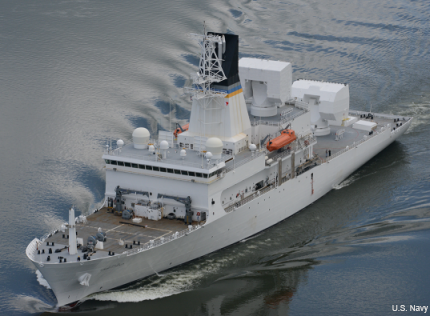Air Force adds ship-based radar to missile-detection network
The Cobra King system will use dual state-of-the-art radars for ballistic missile treaty monitoring and verification.

The Cobra King system is mounted on the USNS Howard O. Lorenzen.
The Air Force Technical Applications Center’s newest ship-based maritime radar has reached operational capability and will join the Defense Department's network of missile-detecting systems.
The Cobra King mobile radar system comprises S- and X-band phased radars to detect missile and space launches and provide high-quality radar data to DOD. The state-of-the-art system is mounted on the USNS Howard O. Lorenzen, which will be operated by Military Sealift Command under a support agreement with AFTAC, according to and Air Force release. MSC is the primary transportation provider for the Defense Department.
The USNS Lorenzen completed its final trials in 2013, successfully testing the ship’s propulsion, damage control, electrical systems, habitability, navigation, supply and deck operations. The ship will be operated by a mixed crew of contractors and military technicians that will operate the radar system, as well as civilians that will navigate the ship.
The radar system uses two large, active electronically scanned array radars. The Lorenzen will use S-Band radar to conduct large volume and multiple target collections, and X-band to provide high-resolution data on objects of interest and to conduct searches.
In order to fulfill its mission of patrolling the air and space, the Air Force sometimes utilizes multi-platform radars for certain missions.
The Cobra King will join DOD’s Cobra network, which consists of several radars designed to monitor missile and space launches for ballistic missile treaty verification. Other radars in the system include an airborne tracker (Cobra Ball), a stationary array (Cobra Dane), and an overseas antenna site (Cobra Shoe).
Cobra King will replace the aging Cobra Judy system that was based on the USNS Observation Island maritime platform, and was originally designated as Cobra Judy Replacement (CJR) prior to becoming operational. Cobra Judy has been deployed since 1981 and due to leave service by 2012, according to an Air Force fact sheet. In addition to conducting treaty monitoring missions, Cobra King will also provide data for domestic ballistic tests.
"This is an extremely exciting time for AFTAC," Col. Chris Worley, AFTAC commander, said in the release. "As Cobra Judy was decommissioned, Cobra King quickly transitioned to ensure our mission of foreign ballistic missile detection was virtually uninterrupted, and we were able to continuously execute our international treaty monitoring responsibilities."
The CJR contract was awarded to primary contractor Raytheon in 2003, according to the company, and was valued at more than $1.74 billion. Raytheon led a team that included Northrop Grumman Electronic Systems, General Dynamics SATCOM Technologies,and Kiewitt Offshore Services.

